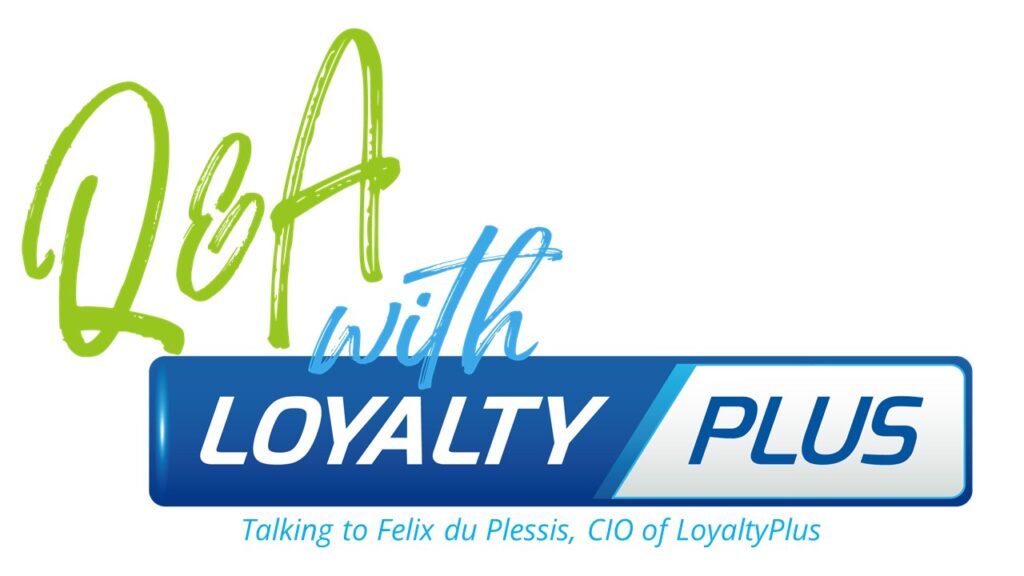
Exploring the API boom and how LoyaltyPlus is staying ahead of the curve to produce various integration services and APIs to enrich the Loyalty programme experience.
Meet our Chief Information Officer (CIO), Felix du Plessis, a seasoned technologist at the helm of our digital transformation. In today’s rapidly evolving business landscape, CIOs like Felix play a pivotal role in shaping the future. They bridge the gap between technology and business strategy, ensuring seamless operations and innovation.
In this discussion, we delve into a topic of paramount importance — ‘APIs and Third-Party Integrations.’ This subject is the lifeblood of modern businesses, where staying competitive hinges on leveraging external resources. Through the lens of Felix, we explore how efficient integration enriches the loyalty program experience, and why this integration is not just a trend but a strategic imperative for any forward-looking organisation.

What are APIs, and how do they relate to loyalty programs?

A core function of IT systems today is the ability to integrate. This is fuelled by the shift to distributed services architectures and the maturity of the cloud allowing pockets of data processing intelligence to be located anywhere in the world. APIs are the contracts that exists between all these distributed systems, that allows them to communicate effectively and securely.
This is even more profound in a Loyalty Ecosystem where program building blocks, partners and end user touch points are functioning as one but distributed across location and corporate boundaries. Having your API house in order improves effective data exchange, leading to better program functionality and eventually enhances customer value.

Is this a new concept?

Application Programming Interfaces (APIs) have been around since before our team members were born. In the pre-1970s, APIs were a way for software pieces to connect with each other. They provided subroutines, methods, or endpoints for programs to communicate with other code or libraries, hiding the internal workings. For instance, APIs allowed accessing specialized graphics libraries or connecting program code with specific databases.
In the 90’s when computer networks became mainstream, the term was expanded to include remote procedure calls. RPCs implemented by CORBA, COM and DCOM made it possible for programs to call routines running on other computers in the network.
The 2000s era of the Web expanded the network to be global and introduced remote calls over HTTP Post methods and SOAP was born. SOAP transmits data in XML format and defines data structure in a cumbersome subset of XML called WSDL. SOAP is still in use but in the process of being replaced by REST.

What maturity level have we reached and where are we going with API technology?

Today most interfaces use REST over HTTP that is less bulky than SOAP and use JSON format for data structures. It is worth looking at GraphQL that is gaining momentum by introducing an API based query language to extract data. This provides data structure without the need to have many API calls and keep on providing new API calls from time to time.
API’s span other technologies like Blockchain, for example you would use a certain published API spec to interface with a certain Blockchain provider or flavour. Tools like (https://swagger.io) provide public API documentation and help to maintain API interfaces.
APIs have evolved from links between programs to the foundation of the API Economy, enabling application development without infrastructure or servers. This has led to serverless code and running on the edge. APIs are crucial in decentralizing the Internet in Web 3.0 with blockchain technology fostering openness and decentralized state.
API driven platforms are designed to deliver fast, provide user authentication, data storage and security to deliver apps in the cloud. Examples are Google Firebase and AWS Amplify.

Wow! Must everyone jump into Firebase or find a Blockchain API provider?

No.
Do not jump in because of the hype or solely let new technologies drive your decisions. API and distributed solutions might not be ideal for:
- Structured data, and migrations;
- Large database applications, factoring in that blockchain transactions could be costly for high transaction volumes;
- Complex and specialized applications;
- Performance;
- Areas where regulation and monitoring is important;
- Querying and data analysis
- Sensitive data and security as the data is not completely yours!
It is important to be aware of the trends and align yourself with the way in which IT is moving, for example:
- Centralised apps move to distributed apps;
- Owning IT upfront moves to renting only what is required;
- Monolithic programs split into smaller manageable services;
- Web 2.0 moves into Web 3.0
- API’s go from Request-Response to Event-Driven.
If you do not innovate you will:
- find no developers supporting your old architecture;
- have to completely re-write systems that have not been maintained;
- sit with expensive infrastructure;
- deal with pressure to comply with modern looks and competitive delivery times;
- have scalability and reliability issues;
- could face global distribution and reach shortcomings.

How does LoyaltyPlus technically provide and maintain its vast number of integrations on offer?

In response to the increasing number of API’s and workloads, we developed a software integration component for our hosting platform. This component, known as the enterprise application integration layer or bus, facilitates external connections, transformation, routing, and protocol conversion.
Our layer makes use of industry standard open components and allows us to easily create scripted integration “routes” between two end points. The one end point being the service provider, partner or customer contract and the other end point connecting it to an internal LoyaltyPlus function, communication channel, service, or data item.
Features of the Integration layer.
- Central domain for integration, whereas before we had integration components in each customers application server.
- Increased visibility of integration routes.
- Increase turnaround time for creating new API functions as the language is scripted and does not require traditional development and release processes.
- Provides the ability to let one customer API call kick off multiple asynchronous calls in the LoyaltyPlus Ecosystem and wait for all to finish before replying to the customer call with combined data packet.
- Provides real-time SOAP to REST API translations to customers where we use legacy code that is still working 100%.
- Security improvements as there is only one place to manage and monitor external interfaces.
- Provides the ability to share common components across domains.
- Provides a good place for measurement and logging.
- Provides redundancy and can scale as we run more than one instance.

How does LoyaltyPlus technically provide and maintain its vast number of integrations on offer?

We are using the Quarkus (quarkus.io) java development framework. I believe that this modern cloud-native java platform is one of the leaders in the enterprise serverless computing world. Quarkus is driven by Red Hat with its roots in the popular JBoss and WildFly application servers. Quarkus 1.0 was released in 2019.
Other major building blocks that form part of our solution is Apache Camel, Hazelcast and Kafka.

So back to loyalty, what are the benefits of integration and how does it enhance the program?

I would say the more the merrier. A Loyalty program should ideally form the backbone of a business model or a benefit cluster. Third parties to the programme comes in various forms, from partners to service providers to end user touch points. The Loyalty program should be easy to access via API’s to have the biggest reach and effectiveness.
Partner integration:
- Grows the programme,
- Accelerates points accrual,
- Provide a variety of redemption options,
- Provides partners with customer insight.
Service providers:
- Payment gateways offer part points part cash payment and points top-up,
- Social media provides status, reach and gamification,
- e-commerce provides integrated shopping experiences,
- Redemption and gift-card providers enhance the customer experience,
- APIs like Travelport brings real-time travel booking to the users fingertips.
Corporate:
- Integrated loyalty offers CRM type functions to other parts of the business,
- Rich data allows for marketing and data analytics.
Integration to end user touch points:
- Mobile applications,
- POS allows for personalization of slips and real-time redemptions,
- Campaigns enhance customer engagement and personalization of the experience.

What challenges should businesses consider when integrating third-party services and APIs into their loyalty programs?

While the benefits are substantial, challenges should not be overlooked.
- Identify the business benefit and do not integrate if there is no gain as integrations are not free of charge.
- Data security and privacy are paramount because customer data is shared with third-party providers. Ensure relevant contracts are in place.
- Smooth integration requires commitment from both parties and a certain amount of ongoing effort is required in order to stay compatible and keep a 24/7 service up.
- Make sure to have clear specifications and only kick off the project when everyone is ready not to waste resources.
Choose partners or service providers that are reliable and do not compromise the customer experience.

Thank you Felix for sharing your insights.

My pleasure. I am keen to tell you more on how we are using containers to optimise our hosting environment and not being locked in by any specific vendor.
Stay tuned for more exclusive Q&A sessions with our senior leaders as we continue to explore the ever-evolving landscape of customer Loyalty.
